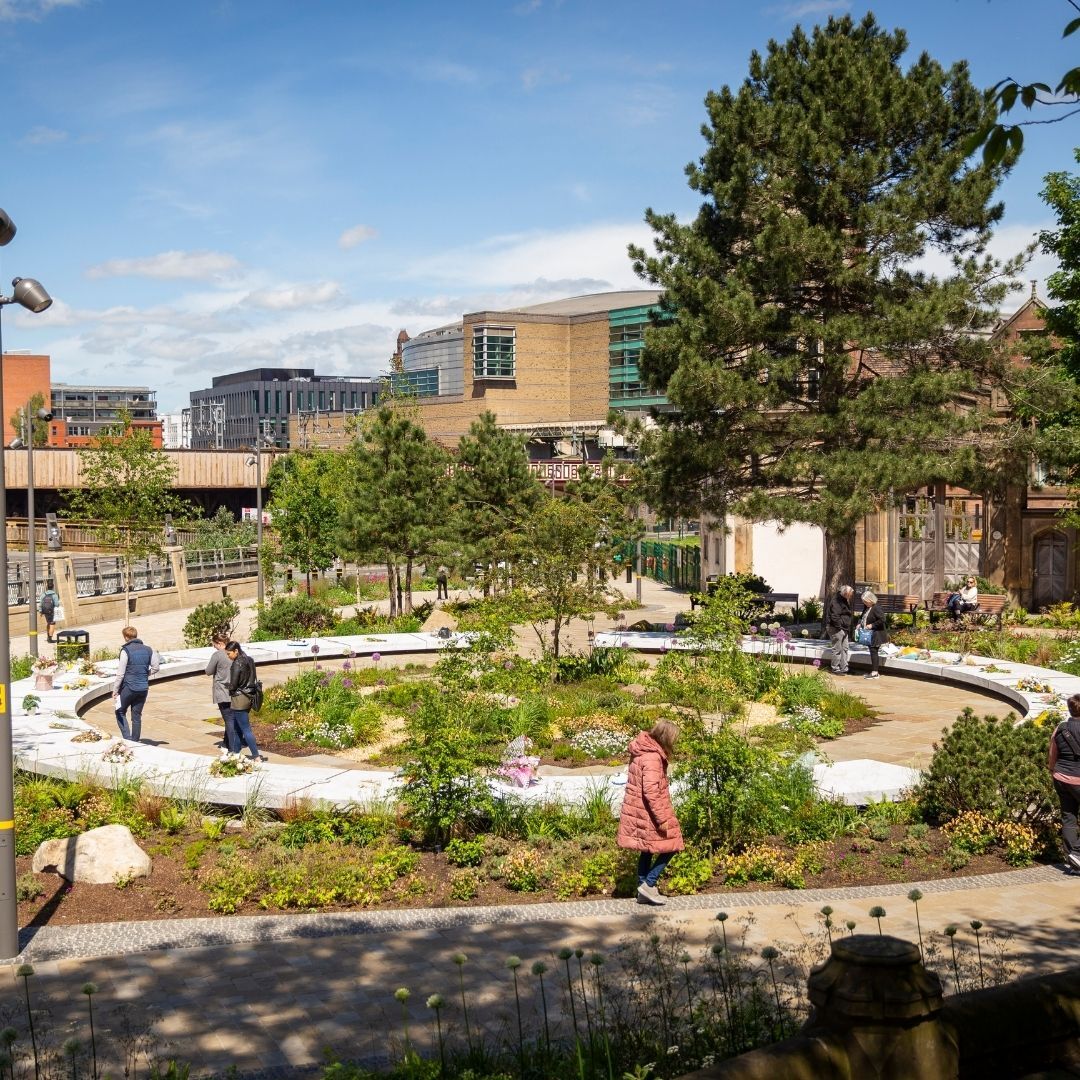Get updates from The Developer straight to your inbox Yes, please!
Glade of Light, Manchester, for Manchester City Council, with Galliford Try, BCA Landscape, Planit, Civic Engineers

The Glade of Light memorial commemorates the 22 lives lost in the Manchester Arena bombing in 2017. The landscape features 28 semi-mature native trees and replaces 40% of the previous hard landscaping with biodiverse planting. Created with input from community engagement and consultation, natural elements create a tranquil environment.
Who is on the project team? (designer, consultants, etc)
Manchester City Council, Galliford Try, BCA Landscape, Planit-IE
Describe the context of this project, its neighbourhood and people.
On 22nd May 2017, 22 people concertgoers and their loved ones waiting for them at Manchester Arena had their lives taken in a terrorist atrocity. In consultation with the families of the victims, Manchester City Council (MCC) worked to identify an appropriate location within the city to create a memorial garden. The Glade of Light is located within the city’s historic Medieval Quarter, by the River Irwell along Victoria Street, close to Manchester Cathedral and Chetham’s School of Music. The Medieval Quarter is a destination in its own right, containing the popular Corn Exchange, Exchange Square and National Football Museum, as well as being a gateway and route into the retail and business core of the city. A public realm masterplan had been developed for the Medieval Quarter in 2016, following public consultation. This included the creation of new riverside liner park along Victoria Street, envisioning a quieter, greener active travel alternative to Corporation Street, providing links to Victoria Station, Salford and Deansgate. The Glade of Light was designed to be a living memorial, tranquil garden space for remembrance and reflection. It’s peaceful surroundings are intended as the setting for commemorative events in the city relating to the attack. The garden and linear park complements its historic setting and provides further amenity value as an active travel route. The memorial features a white marble halo with the names of those that lost their lives in bronze surrounded by a seasonal native planting, providing colour and maximising light all year round.
How does this public space bring people together, encourage inclusivity, and make a positive environmental impact to the wider place? How is the community engaged in the project?
Inclusivity has been imbedded in all aspects of the design, working with representatives of the bereaved families, survivors, local stakeholders and an access-for-all group to ensure input from diverse interests and perspectives. This ongoing engagement resulted in changes throughout the evolution of the design of the project, including changes to seating design, reduction in the height of the memorial halo and the introduction of braille text. A previously under-utilised area of the City has now been re-imagined as a significant shared public resource, which is used for civic acts of remembrance, quiet reflection and general utility. The project removed an existing road and parking, introducing a new cycle and pedestrian route in addition to planting. Existing Yorkstone paving was reused on the site, which was critical in achieving the net carbon neutrality vision for the project. A large existing pine tree was retained on site, with an additional 28 new semi-mature native trees planted to contribute to on-going carbon sequestration and mitigating climate change. 40% of the previous hard landscaping was replaced with a bio-diverse planting scheme to help reduce the urban heat island in the vicinity and maximise adaptation to future climate changes. A further 30% of the site saw the replacement of lawns with more bio-diverse planting, maximising opportunities for pollinators through-out the year. The project also benefits from a sustainable urban drainage system, which helps to reduce stormflow, naturally filtering water and reducing the requirement for additional watering.
Please share any data or figures that support your entry about how this public space or landscape intervention has made a positive social or environmental impact, for example biodiversity, increased dwell time, flood or drainage mitigation, wellness or safety or other ecosystem services
The project will be climate positive in approximately 33 years’ time, with a net carbon impact over 50 years of 27-27,000kg of C02 sequestered. 40% of the hard landscape from the previous site area has been replaced with a bio-diverse planting scheme with a sustainable urban drainage system below. A biodiversity net gain of approximately +10% is produced. The project was mindful of making a positive contribution towards the UN Sustainable Development Goals, including specifically: 3 – Good Health and Wellbeing; 10 – Reduced inequalities; 11 – Sustainable Cities and Communities; 12 – Responsible Consumption and Production; 13 – Climate Action; and 15 – Life on Land. The design team have ensured that the project is consistent with and exceeds all the relevant current UK best practice and standards. This includes reference to and analysis of – Lifetime Material Costs, Accessibility an Inclusivity, sustainability (including Carbon Sequestration and Bio-diversity Net Gain), sustainable urban drainage and the British Standards in general.
Sign up to our newsletter
Get updates from The Developer straight to your inbox
Thanks to our organisation members
© Festival of Place - Tweak Ltd., 124 City Road, London, EC1V 2NX. Tel: 020 3326 7238